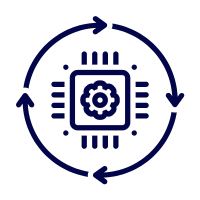NARFIN (Narwhal Financial Systems) is a Singapore-based fintech spin-off from SMU, delivering next-generation digital banking and financial management solutions. NARFIN’s platform empowers banks, remittance houses, MNCs, and digital financial institutions to streamline treasury, remittance, and core banking operations with modular, cloud-ready systems. The company’s technology is proven in production environments and trusted by leading clients in Asia.
Icon

Future of learning isn’t a static course, but an intelligent AI guide that adapts to the learner. Aacharya is an enterprise grade trustworthy AI-based training and assessment guide, built ground up after years of research on human-ability-modelling, that automates generation of training and assessment content based on private un-curated raw data, human-ability and science of learning principles.
Technology Enhanced Learning (TEL) is about using technology to help students achieve learning outcomes in a course by positively influencing their learning behaviour, as well as enhancing their knowledge construction and social interaction. Throughout the years, the Centre for Teaching Excellence have been helping faculty members to develop innovative TEL Projects that help to drive and achieve course learning outcomes. These projects involve a variety of media including, games, simulations, learning objectives, virtual reality applications, web applications and many more.
HyperAgent is a cutting-edge multi-agent framework designed to revolutionize the software development landscape. By harnessing the power of natural language processing, HyperAgent enables users to articulate their software requirements in a clear and intuitive manner. This framework operates within Version Control Systems (VCSes), like GitHub, streamlining the process of software generation, particularly for smart contracts in the Solidity programming language. HyperAgent addresses the challenges of traditional development processes by offering a more flexible and user-friendly interface for generating and refining software applications.
The Mando-LLM framework presents an innovative approach to smart contract bug detection, leveraging advanced machine learning techniques for improved accuracy and adaptability. In a rapidly evolving digital landscape where blockchain technology is becoming increasingly central, ensuring the security and reliability of smart contracts is paramount. Mando-LLM enhances the detection of bugs by utilizing a combination of semantic-aware code representations, enabling a more profound understanding of the code's intent and structure. This capability is crucial for identifying vulnerabilities that could be exploited in real-world applications.
Operating system (OS) kernels are critical components of modern computing systems, managing hardware resources and providing essential services to applications. However, due to their complexity, kernels are often vulnerable to various security issues like bugs, vulnerabilities, and malicious attacks. The kernel’s reliability and security are of utmost importance, as any breach could compromise the entire system.
Managing crowds and optimising the flow of people in capacity-constrained environments, such as theme parks, shopping malls, convention centers, and sports arenas, can be challenging. Crowds lead to congestion, long queues, and poor user experiences if not managed effectively. Traditional crowd control systems often lack the flexibility to respond to real-time changes, making it difficult for operators to optimise the use of space and resources.
Breathing mode, whether oral or nasal, holds significance in both performance sports and sleep quality. Nasal breathing is favored during endurance activities like distance running due to its efficiency in air filtration, humidification, and warming, which enhances oxygen exchange and reduces respiratory discomfort. Moreover, nasal breathing encourages better pacing control and endurance through diaphragmatic breathing. While oral breathing may be advantageous during high-intensity bursts of activity, the choice between nasal and oral breathing depends on individual factors such as fitness level and respiratory health.
Similarly, in sleep, nasal breathing plays a crucial role in maintaining optimal airflow, promoting efficient oxygen exchange, and reducing the risk of respiratory issues like snoring and sleep apnea. Conversely, chronic oral breathing during sleep can lead to various problems, including disruptions in sleep patterns and increased risk of respiratory infections and dental issues.
Therefore, having the ability to monitor and effect change in the breathing mode, whether oral or nasal, can contribute to overall respiratory health and well-being of individuals engaging in sport or health and wellness activities.
The Integrated Feedback on Student Learning Outcomes for Improvement and Growth (INSIGHT) System is an eLearn (SMU’s Learning Management System)-integrated web-application that allows instructors to map SMU’s Graduate Learning Outcomes to course learning outcomes and to assessment parts (rubric items for assignments, sections in quizzes) within a course.
The INSIGHT System uses eLearn assessment scores to feed a learning outcome dashboard for students and instructors. It allows instructors to track students progress, as individuals and as a class, for course and graduate learning outcomes
It works by mapping Assessments to Course Learning Outcomes linked to SMU’s Graduate Learning Outcomes.
This allows instructors to adjust their instructional strategies in accordance with the attainment of these learning outcomes. It allows students more personalised coaching and advice during consultation sessions.
The prevalence of sophisticated malware threats has risen significantly, posing serious risks to computer systems by inflicting substantial damage, compromising sensitive data, and resulting in financial losses. Recent incidents, such as hackers targeting Android users with a trojanised version of the Telegram app , and Google suspending an e-commerce app Pinduoduo over malware concerns, highlight the urgency for robust mobile security solutions. It is noteworthy that Android devices, constituting approximately 70% of the global market share , are particularly vulnerable, emphasizing the critical importance of effective security measures in this widely utilised environment.
JOIN OUR MAILING LIST
Build your network and get plugged into our community of 10,000+ startups, innovators, student founders and tech gurus by subscribing to our e-newsletter!